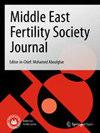Effect of intra-ovarian injection of platelet-rich plasma on the patients with a poor ovarian response (POR) or premature ovarian insufficiency (POI): a systematic review and meta-analysis
IF 1.3
Q4 REPRODUCTIVE BIOLOGY
引用次数: 0
Abstract
POR or POI poses a significant challenge to fertility treatment with different ovarian stimulation strategies. Intra-ovarian injection of platelet-rich plasma (PRP) has been hypothesised to improve ovarian reserve and pregnancies in POI or POR. However, its effectiveness on pregnancy, embryology and ovarian reserve outcomes need to be established. Therefore, we systematically searched databases based on PRISMA guidelines that reported on the effects of intra-ovarian autologous PRP injections in sub-fertile women with POI and POR. The following outcome effects were analysed by random model and included in the meta-analysis in pre- and post-PRP injection groups of POI & POR: (a) pregnancy rates, rate of oocyte & embryo formation (b) ovarian reserve markers (Antral follicular count, Anti-Mullerian Hormone, Follicle Stimulating Hormone). A separate analysis of pregnancies, AFC and AMH was done in POI and POR groups and in age groups < 35 years and > 35 years. A total of 12 studies were included. The estimated overall effects size of the log odds ratio (log OR = 2.03; 95% CI = 0.13 to 3.92; P = 0.04; I2 = 0.42) favoured post-PRP with a moderate level of evidence. There are no significant differences in POI/POR and those with < 35 years or > 35 years. The pooled standard difference of means favoured the post-PRP injection group significantly with regards to rates of embryo formation (1.39; 95% CI = 0.56 to 2.21; P = 0.02; I2 = 46%.), Oocyte (0.84; 95% CI = -1.3 to 3.0; P = 0.24; I 2 93%), Antral follicle count (1.78; 95% CI = 0.73 to 2.84; P = 0.01. I2 = 97%) with a low level of evidence and Anti-Mullerian Hormone (1.11; 95% CI = 0.16 to 2.05; P = 0.03; I2 = 96%) with low level of evidence. Our study shows that intraovarian PRP injection was associated with no significant increase in the rates of pregnancy, in the rates of pregnancy, oocyte, embryo formation, Anti-Mullerian Hormone and antral follicle count. Live birth rates were not calculated. There was no statistical difference between POR/POI and those with < 35 years or > 35 years. Further randomized studies are warranted to confirm our findings.卵巢内注射富血小板血浆对卵巢反应不良(POR)或卵巢早衰(POI)患者的影响:系统综述和荟萃分析
POR或POI对采用不同卵巢刺激策略的生育治疗构成了巨大挑战。卵巢内注射富血小板血浆(PRP)被认为可改善 POI 或 POR 的卵巢储备和妊娠。然而,其对妊娠、胚胎学和卵巢储备结果的有效性还有待证实。因此,我们根据 PRISMA 指南,系统地检索了对患有 POI 和 POR 的亚健康女性进行卵巢内自体 PRP 注射的效果进行报道的数据库。荟萃分析采用随机模型对 POI 和 POR 注射前后两组的下列结果效应进行了分析:(a)妊娠率、卵母细胞和胚胎形成率(b)卵巢储备指标(前卵泡计数、抗穆勒氏管激素、卵泡刺激素)。对 POI 组和 POR 组以及 35 岁年龄组的妊娠、AFC 和 AMH 进行了单独分析。共纳入了 12 项研究。估计的总效应对数比(log OR = 2.03; 95% CI = 0.13 to 3.92; P = 0.04; I2 = 0.42)倾向于后PRP,证据等级为中等。POI/POR与35岁以上者无明显差异。在胚胎形成率(1.39;95% CI = 0.56 至 2.21;P = 0.02;I2 = 46%)、卵母细胞(0.84;95% CI = -1.3 至 3.0;P = 0.24; I 2 93%)、前卵泡计数(1.78; 95% CI = 0.73 to 2.84; P = 0.01. I2 = 97%)证据水平较低,抗苗勒氏管激素(1.11; 95% CI = 0.16 to 2.05; P = 0.03; I2 = 96%)证据水平较低。我们的研究表明,卵巢内注射 PRP 与妊娠率、妊娠率、卵母细胞率、胚胎形成率、抗穆勒氏激素和前卵泡数无显著相关性。活产率没有计算在内。POR/POI与 35 岁者之间没有统计学差异。需要进一步的随机研究来证实我们的发现。
本文章由计算机程序翻译,如有差异,请以英文原文为准。
求助全文
约1分钟内获得全文
求助全文
来源期刊

Middle East Fertility Society Journal
REPRODUCTIVE BIOLOGY-
CiteScore
2.80
自引率
0.00%
发文量
32
审稿时长
45 weeks
 求助内容:
求助内容: 应助结果提醒方式:
应助结果提醒方式:


